Charles E W Bean, Diaries, AWM38 3DRL 606/274/1 - 1918 - 1941 - Part 2
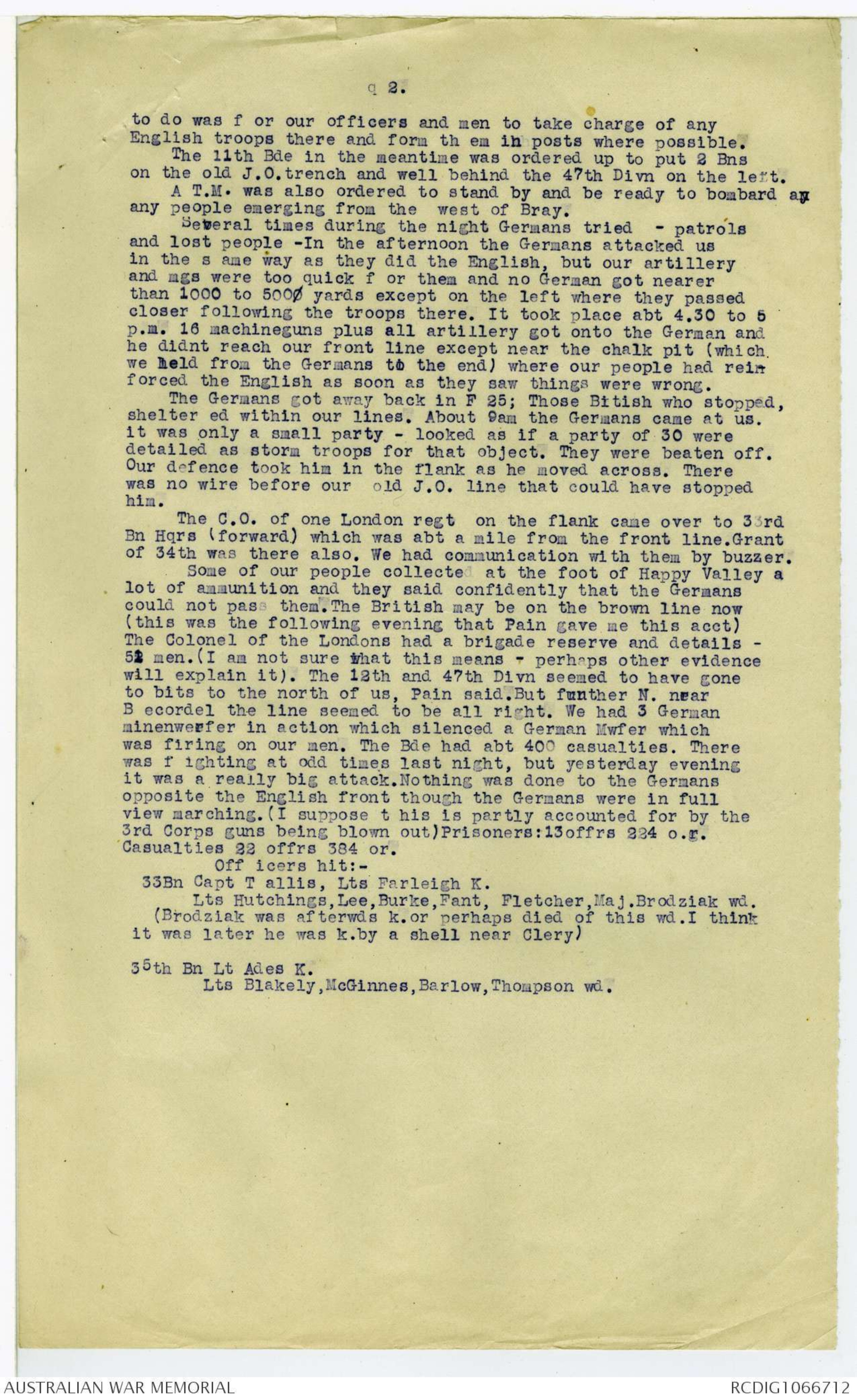
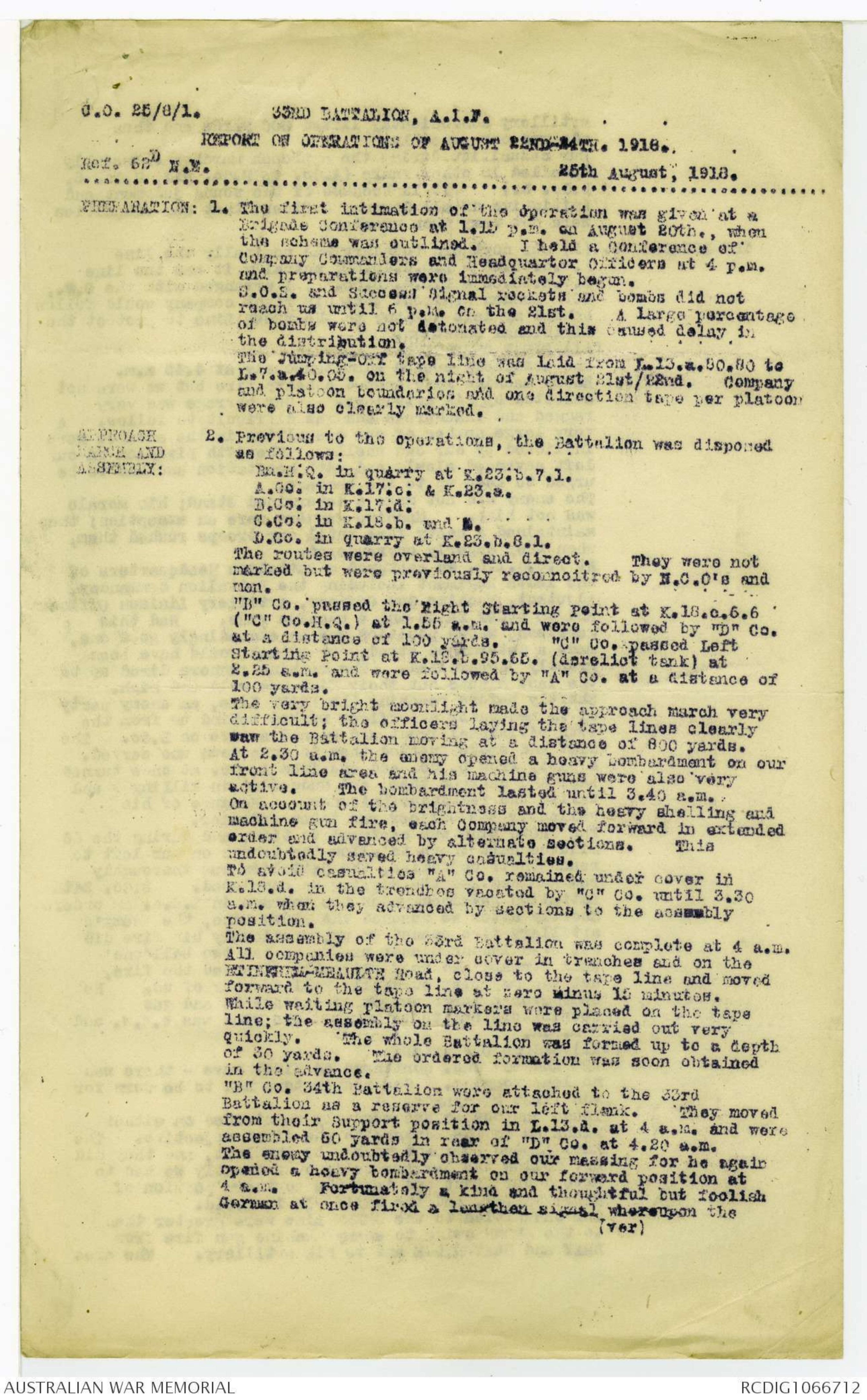
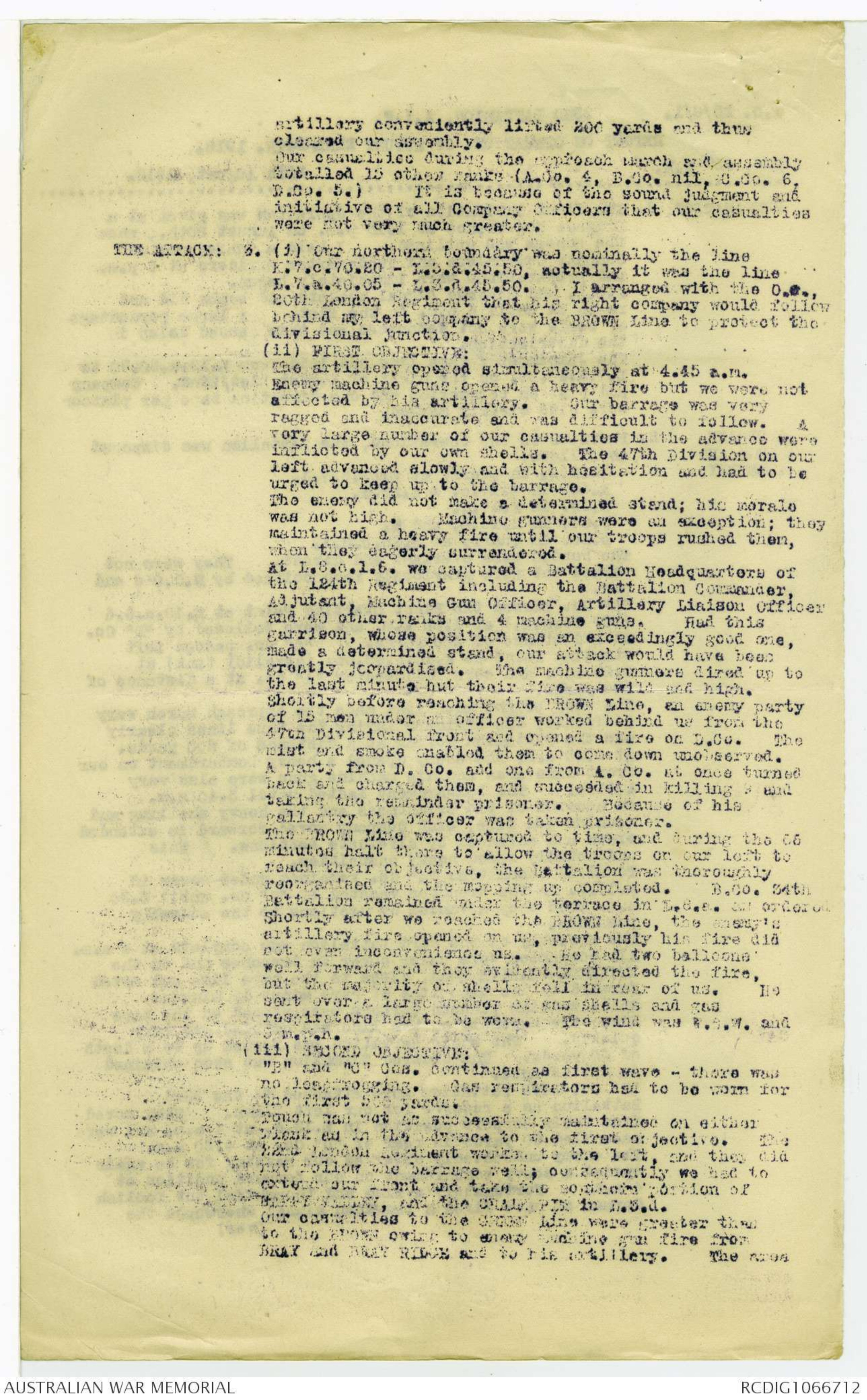

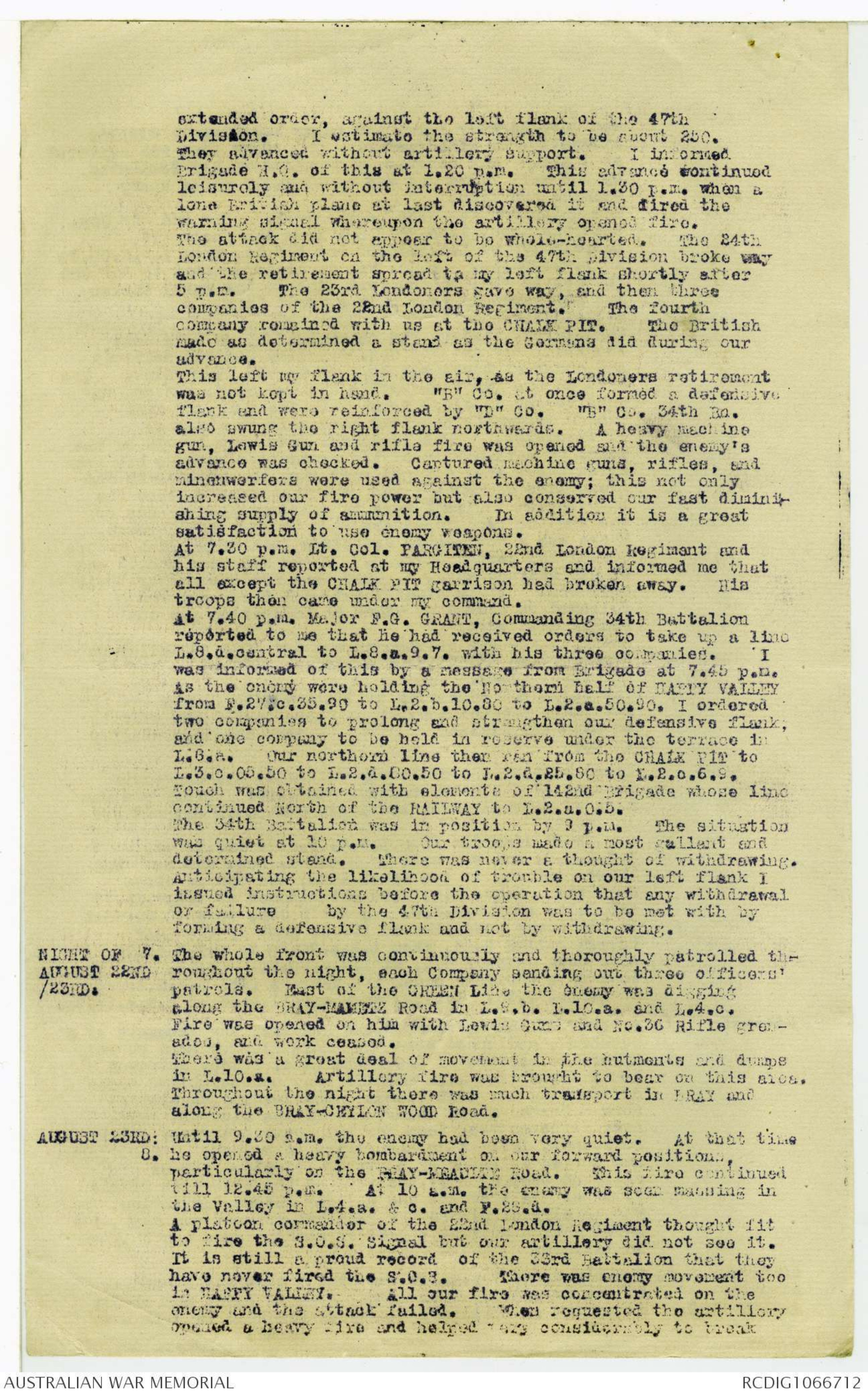

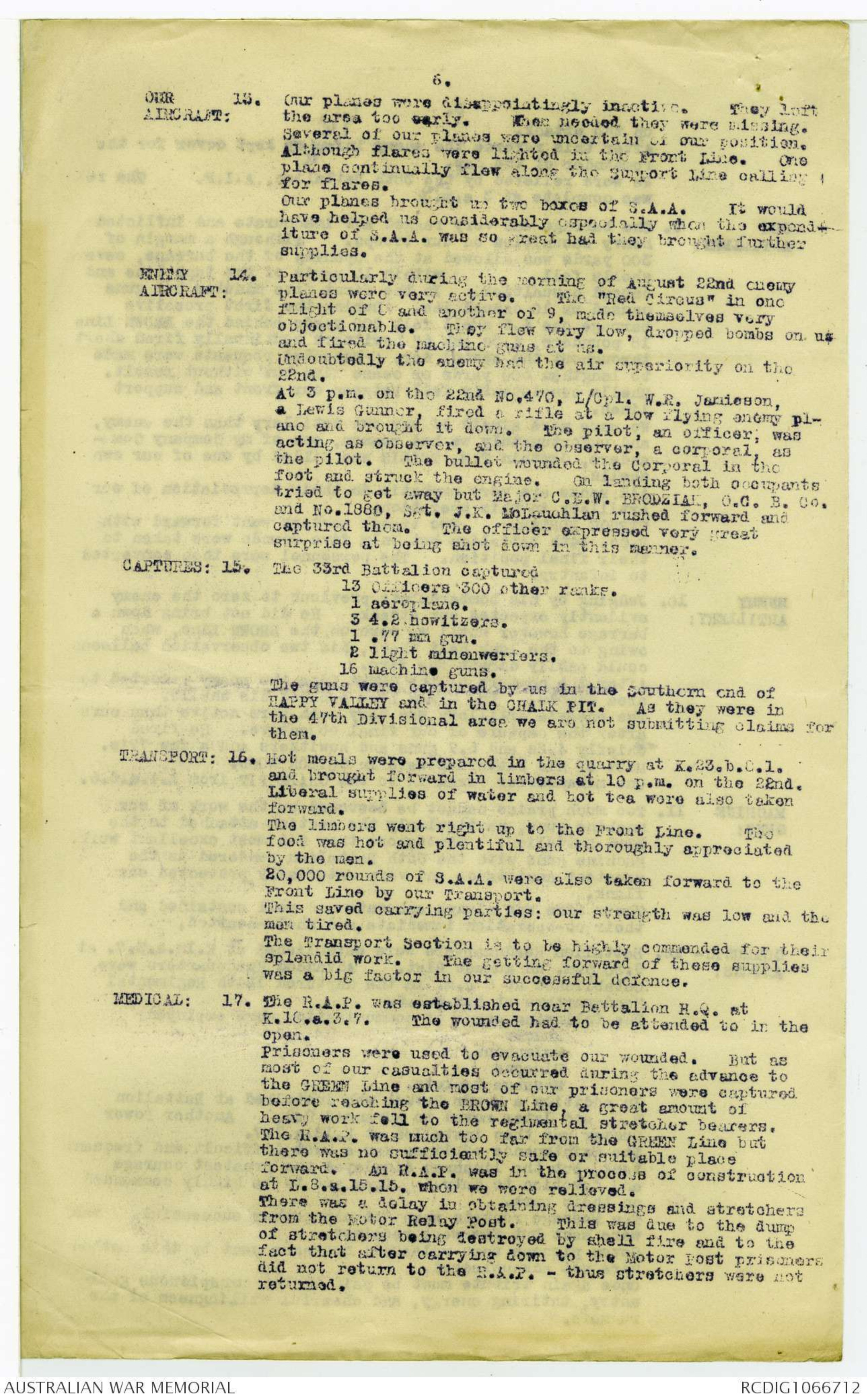
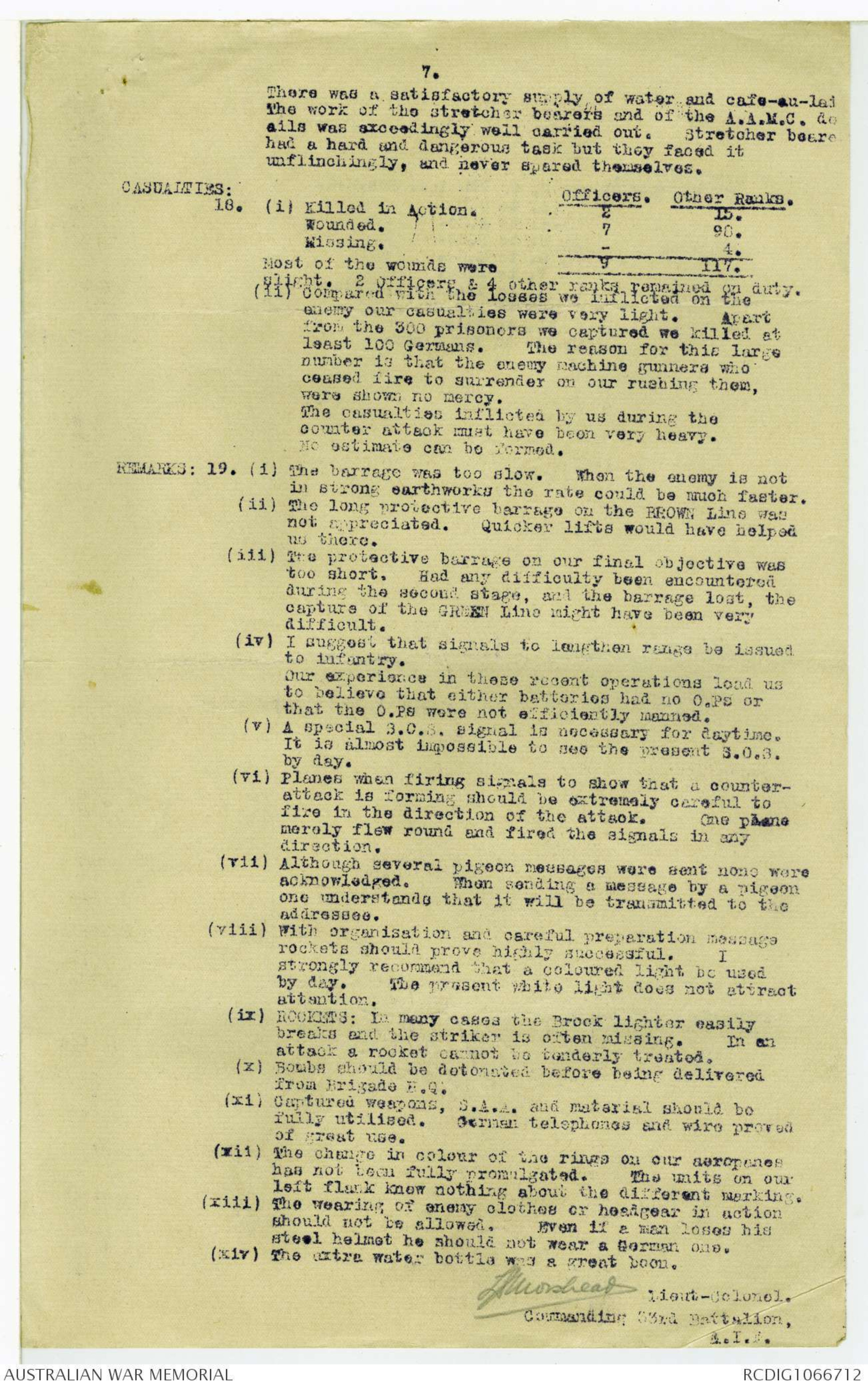
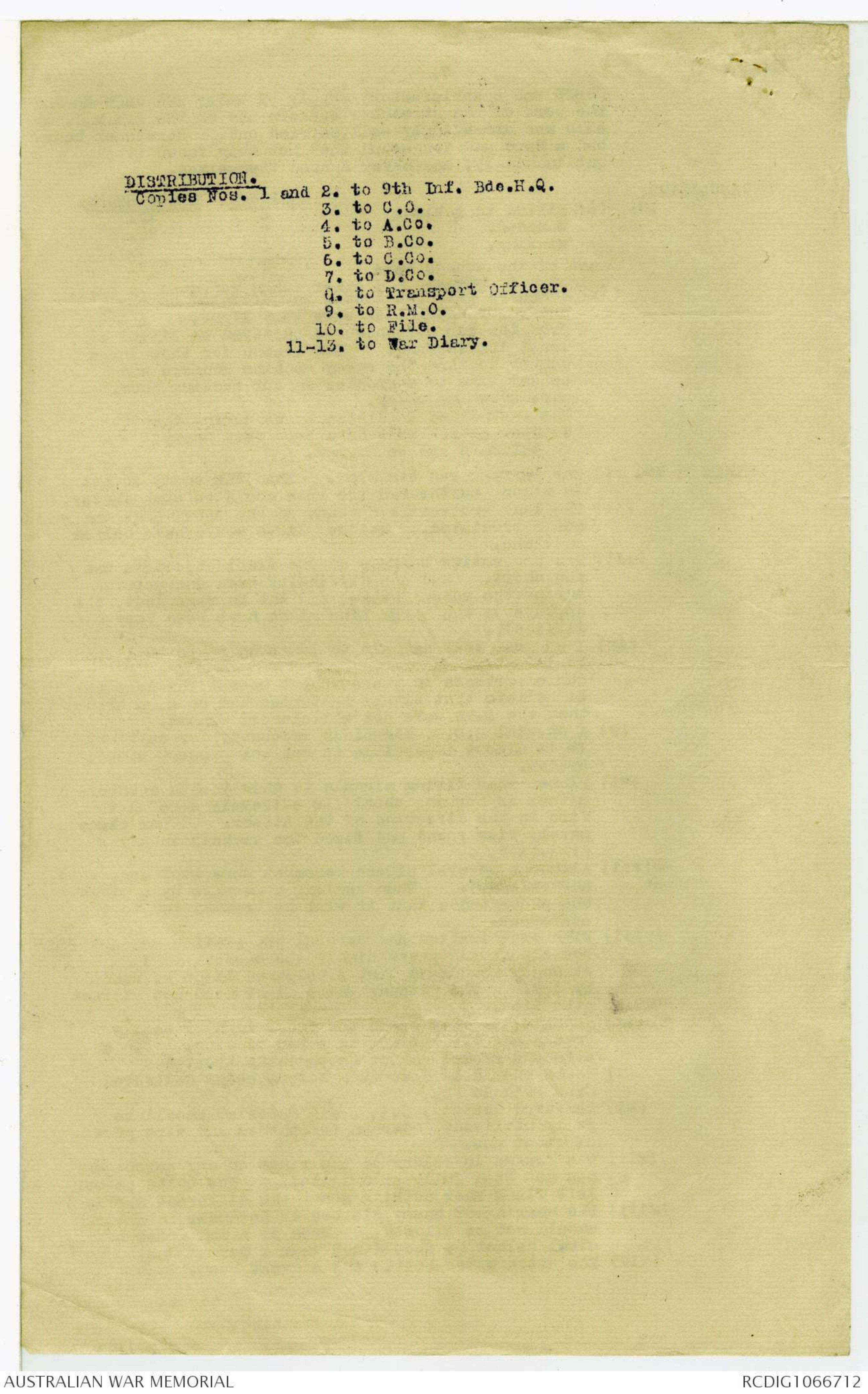

q 2.
to do was f or our officers and men to take charge of any
English troops there and form th em in posts where possible.
The 11th Bde in the meantime was ordered up to put 2 Bns
on the old J.O.trench and well behind the 47th Divn on the left.
A T.M. was also ordered to stand by and be ready to bombard an
any people emerging from the west of Bray.
Several times during the night Germans tried - patrols
and lost people -In the afternoon the Germans attacked us
in the s ame way as they did the English, but our artillery
and mgs were too quick f or them and no German got nearer
than 1000 to 5000 yards except on the left where they passed
closer following the troops there. It took place abt 4.30 to 5
p.m. 16 machineguns plus all artillery got onto the German and
he didn't reach our front line except near the chalk pit (which
we held from the Germans to the end) where our people had
reinforced the English as soon as they saw things were wrong.
The Germans got away back in F 25; Those Bitish who stopped,
shelter ed within our lines. About 9am the Germans came at us.
it was only a small party - looked as if a party of 30 were
detailed as storm troops for that object. They were beaten off.
Our defence took him in the flank as he moved across. There
was no wire before our old J.O. line that could have stopped
him.
The C.O. of one London regt on the flank came over to 33rd
Bn Hqrs (forward) which was abt a mile from the front line.Grant
of 34th was there also. We had communication with them by buzzer.
Some of our people collected at the foot of Happy Valley a
lot of ammunition and they said confidently that the Germans
could not pass them.The British may be on the brown line now
(this was the following evening that Pain gave me this acct)
The Colonel of the Londons had a brigade reserve and details -
52 men.(I am not sure what this means - perhaps other evidence
will explain it). The 12th and 47th Divn seemed to have gone
to bits to the north of us, Pain said.But further N. near
B ecordel the line seemed to be all right. We had 3 German
minenwerfer in action which silenced a German Mwfer which
was firing on our men. The Bde had abt 400 casualties. There
was f ighting at odd times last night, but yesterday evening
it was a really big attack.Nothing was done to the Germans
opposite the English front though the Germans were in full
view marching.(I suppose t his is partly accounted for by the
3rd Corps guns being blown out)Prisoners:13offrs 224 o.r.
Casualties 22 offrs 384 or
Off icers hit:-
33Bn Capt T allis, Lts Farleigh K.
Lts Hutchings,Lee,Burke,Fant, Fletcher,Maj.Brodziak wd.
(Brodziak was afterwds k.or perhaps died of this wd.I think
it was later he was k.by a shell near Clery)
35th Bn Lt Ades K.
Lts Blakely,McGinnes,Barlow,Thompson wd.
C.O. 25/8/1. 33RD BATTALION, A.I.F.
REPORT OF OPERATIONS OF AUGUST 22ND-24TH. 1918.
Ref. 62D N.E. 25th August, 1918.
PREPARATION: 1. The first intimation of the operation was given at a
Brigade Conference at 1.15 p.m. on August 20th., when
the scheme was outlined. I held a Conference of
Company Commanders and Headquarter Officers at 4 p.m.
and preparations were immediately begun.
S.O.S. and Success Signal rockets and bombs did not
reach us until 6 p.m. on the 21st. A large percentage
of bombs were not detonated and this caused delay in
the distribution.
The Jumping-Off tape line was laid from J.13.a.50.80 to
L.7.a.40.05. on the night of August 21st/22nd. Company
and platoon boundaries and one direction tape per platoon
were also clearly marked.
APPROACH 2. Previous to the operations, the Battalion was disposed
MARCH AND as follows:
ASSEMBLY: Bn.H.Q. in quarry at K.23.b.7.1.
A.Co. in K.17.c. & K.23.s.
B.Co. in K.17.d.
C.Co. in K.18.b. and K.
D.Co. in quarry at K.23.b.8.1.
The routes were overland and direct. They were not
marked but were previously reconnoitred by N.C.O's and
men.
"B" Co. passed the Right Starting point at K.18.c.6.6
("C" Co.H.Q.) at 1.55 a.m. and were followed by "D" Co.
at a distance of 100 yards. "C" Co. passed Left
Starting Point at K.18.b.95.65. (derelict tank) at
2.25 a.m. and were followed by "A" Co. at a distance of
100 yards.
The very bright moonlight made the approach march very
difficult; the officers laying the tape lines clearly
saw the Battalion moving at a distance of 800 yards.
At 2.30 a.m. the enemy opened a heavy bombardment on our
front line area and his machine guns were also very
active. The bombardment lasted until 3.40 a.m.
On account of the brightness and the heavy shelling and
machine gun fire, each Company moved forward in extended
order and advanced by alternate sections. This
undoubtedly saved heavy casualties.
To avoid casualties "A" Co. remained under cover in
K.18.d. in the trenches vacated by "C" Co. until 3.30
a.m. when they advanced by sections to the assembly
position.
The assembly of the 33rd Battalion was complete at 4 a.m.
All companies were under cover in trenches and on the
[[ETINEREIL-MEAULTE?]] Road, close to the tape line and moved
forward to the tape line at zero minus 15 minutes.
While waiting platoon markers were placed on the tape
line; the assembly on the line was carried out very
quickly. The whole Battalion was formed up to a depth
of 30 yards. The ordered formation was soon obtained
in the advance.
"B" Co. 34th Battalion were attached to the 33rd
Battalion as a reserve for our left flank. They moved
from their Support position in L.13.d. at 4 a.m. and were
assembled 60 yards in rear of "D" Co. at 4.20 a.m.
The enemy undoubtedly observed our massing for he again
opened a heavy bombardment on our forward position at
4 a.m. Fortunately a kind and thoughtful but foolish
German at once fired a [[lengthen?]] signal whereupon the
(ver)
artillery conveniently lifted 200 yards and thus
cleared our assembly.
Our casualties during the approach march and assembly
totalled 15 other ranks (A.Co. 4, B.Co. nil, C.Co. 6,
D.Co. 5.) It is because of the sound judgment and
initiative of all Company Officers that our casualties
were not very much greater.
THE ATTACK: 3. (i) Our northern boundary was nominally the line
K.7.c.70.20 - L.3.d.45.50, actually it was the line
L.7.a.40.05 - L.3.d.45.50. I arranged with the O.C.,
20th London Regiment that his right company would follow
behind my left company to the BROWN Line to protect the
divisional junction.
(ii) FIRST OBJECTIVE:
The artillery opened simultaneously at 4.45 a.m.
Enemy machine guns opened a heavy fire but we were not
affected by his artillery. Our barrage was very
tagged an inaccurate and was difficult to follow. A
very large number of our causualties in the advance were
inflicted by our own shells. The 47th Division on our
left advanced slowly and with hesitation and had to be
urged to keep up to the barrage.
The enemy did not make a determined stand; his morale
was not high. Machine gunners were an exception; they
maintained a heavy fire until our troops rushed them,
when they eagerly surrendered.
At L.8.e.1.6. we captured a Battalion Headquarters of
the 124th Regiment including the Battalion Commander,
Adjutant, Machine Gun Officer, Artillery Liaison Officer
and 40 other ranks and 4 machine guns. Had this
garrison, whose position was an exceedingly good one,
made a determined stand, our attack would have been
greatly jeopardised. The machine gunners dired up to
the last minute but their fire was wild and high.
Shortly before reaching the BROWN Line, an enemy party
of 15 men under an officer worked behind us from the
47th Divisional front and opened a fire on D.Co. The
mist and smoke enabled them to come down unobserved.
A party from D. Co. add one from A. Co. at once turned
back and charged them, and succeeded in killing and
taking the remainder prisoner. Because of his
gallantry the Officer was taken prisoner.
the BROWN Line was captured to time, and during the 55
minutes halt there to allow the troops on our left to
reach their objective, the Battalion was thoroughly
reorganised and the mopping up completed. B.Co. 34th
Battalion remained under the terrace in L.8.a. as ordered
Shortly after we reached the BROWN Line, the enemy's
artillery fire opened on us, previously his fire did
not even inconvenience us. He had two balloons
well forward and they evidently directed the fire,
but the majority of shells fell in rear of us. He
sent over a large number of gas shells and gas
respirators had to be worn. The wind was [[?]].S.W. and
5 m.p.h.
(iii) SECOND OBJECTIVE:
"B" and "C" Cos. continued as first wave - there was
no leapfrogging. Gas respirators had to be worn for
the first 500 yards.
Touch was not as successfully maintained on either
flank as in the advance to the first objective. The
22nd London Regiment worked to the left, and they did
not follow the barrage well; consequently we had to
extend our front and take the northern portion of
Happy Valley, and the Chalk Pits, in L.5.d.
Our casualties to the GREEN Line were greater than
to the BROWN owing to enemy machine gun fire from
BRAY and BRAY RIDGE and to his artillery. The area
3.
was more lightly held; the enemy had time to display
discretion by withdrawing. The GREEN Line was captured
at 3 a.m. The position was uncomfortably dominated
by the BRAY RIDGE and was continually under heavy
machine gun fire.
The Battalion was soon reorganised. "B" and "C" Cos.
held the front line, "B" Co. from the Chalk Pit,
L.3.d.50.90 to L.9.b.40.65 and "C" Co. from L.3.d.50.90
to L.9.d.35.60. A.Co. was in close support to "C" and
"D" Co. to "B"; the support line in the early stages
was 100 yards in rear of the front line.
(iv) LIAISON.
The closest liaison was maintained by us with both
flanks. "A" and "D" Cos. supplied liaison sections
and constant touch was kept up to the BROWN Line. The
halt at the first objective enabled O..C. "B" and "D"
Cos. to get in close touch with the 20th and 22nd
London Regiments and they were able to clear up
difficulties. The Londoners knew very little of the
plan; no explanation of the protective barrage had been
given them; they did not know when the advance to the
green line commenced; nor were they sure whether the
20th London Regiment were to continue the advance or
whether the 22nd Londoners were to leapfrog through.
There was a noticeable dribbling back of English troops
during the second advance. These men were unhurt and
simply drifted away. They were not checked by their
officers. It is significant that those men who
followed us showed no signs of hesitation and did
really good work.
Owing to the gap between us and the 35th Battalion on
our right we established a liaison platoon to secure
our right flank.
The value and necessity of liaison with flanks are not
yet fully appreciated. In these operations efforts
to maintain liaison were confined chiefly
to us.
CONSOLIDATION: Consolidation was extremely difficult and dangerous
4. becuase of the heavy machine gun fire. Every use was
made of natural cover and Lewis gun posts established
in front.
Our front line ran from L.9.d.35.60 - L.9.b.5.4. -
L.3.d.6.9. and was held by B and C. Cos. who each had
three platoons in the front line, and one in close
support. B.Co. H.Q. were established at L.3.d.25.70
and C.Co. at L.9.b.3.6. A and D Cos. were in support
in old enemy positions in L.9.a. East of the BRAY -
HAPPEY VALLEY Road, from L.9.a.70.50 to L.9.d.40.95,
with both Company H.Q. at L.9.a.30.90. B.Co. 34th Bn.
took up a position under the terrace from L.9.a.20.50
to L.8.b.95.95. Co.H.Q. were established at L.9.a.10.90.
CAVALRY: 5. A party of the Northumberland Hussars, the remnants of a
squadron, gallopped down the BRAY-FRICOURT Road shortly
after the capture of the GREEN Line. They suffered
heavy casualties from machine guns and aeroplane bombs
on reaching our left flank. The leading cavalryman
wore a Germen steel helmet and in the mist and smoke
some rifleman took them for the enemy and fired about
20 rounds, inflicting casualties to horses. 2 Officers
and 10 men followed by about 20 riderless horses
galloped towards BRAY and reached the outskirts of the
village. All except one officer became casualties.
The cavalry displayed the greatest courage and dash, but
shock action against a nest of machine guns can only end
in failure.
COUNTERATTACK: 6. Shortly after 1 p.m. on the 22nd I observed a counter
attack developing from [[CARTIT?]] WOOD in F.18. and slowly
AUGUST 22nd. advancing in artillery formation preceded by a line in
(over)
extended order, against the left flank of the 47th
Division. I estimate the strength to be about 250.
They advanced without artillery support. I informed
Brigade H.Q. of this at 1.20 p.m. This advance continued
leisurely and without interruption until 1.30 p.m. when a
lone British plane at last discovered it and fired the
warning signal whereupon the artillery opened fire.
The attack did not appear to be whole-hearted. The 24th
London Regiment on the left of the 47th Division broke way
and the retirement spread to my left flank shortly after
5 p.m. The 23rd Londoners gave way, and then three
companies of the 22nd London Regiment. The fourth
company remained with us at the CHALK PIT. The British
made as determined stand as the Germans did during our
advance.
This left my flank in the air, as the Londoners retirement
was not kept in hand. "B" Co. at once formed a defensive
flank and were reinforced by "D" Co. "B" Co. 34th Bn.
also swung the right flank northwards. A heavy machine
gun, Lewis Gun and rifle fire was opened and the enemy's
advance was checked. Captured machine guns, rifles, and
minenwerfers were used against the enemy; this not only
increased our fire power but also conserved our fast diminishing
supply of ammunition. In addition it is a great
satisfaction to use enemy weapons.
At 7.30 p.m. Lt. Col. PARGITEN, 22nd London Regiment and
his staff reported at my Headquarters and informed me that
all except the CHALK PIT garrison had broken away. His
troops then came under my command.
At 7.40 p.m. Major F.G. GRANT, Commanding 34th Battalion
reported to me that he had received orders to take up a line
L.8.d.central to L.8.a.9.7. with his three companies. I
was informed of this by a message from Brigade at 7.45 p.m.
as the enemy were holding the northern half of HAPPY VALLEY
from F.27.c.35.90 to L.2.b.10.80 to L.2.a.50.90. I ordered
two companies to prolong and strengthen our defensive flank,
and one company to be held in reserve under the terrace in
L.8.a. Our northern line then ran from the CHALK PIT to
L.3.c.05.50 to L.2.d.80.50 to L.2.d.25.80 to L.2.c.6.9.
Touch was obtained with elements of 142nd Brigade whose line
continued North of the RAILWAY to L.2.a.0.5.
The 34th Battalion was in position by 9 p.m. The situation
was quiet at 10 p.m. Our troops made a most gallant and
determined stand. There was never a thought of withdrawing.
Anticipating the likelihood of trouble on our left flank I
issued instructions before the operation that any withdrawal
or failure by the 47th Division was to be met with by
forming a defensive flank and not by withdrawing.
NIGHT OF 7. The whole front was continuously and thoroughly patrolled
AUGUST 22ND throughout the night, each Company sending out three officers'
/23RD. patrols. East of the GREEN Line the enemy was digging
along the BRAY-MAMETE Road in L.8.b. L.10.a. and L.4.c.
Fire was opened on him with Lewis Guns and No.36 Rifle grenades,
and work ceased.
There was a great deal of movement in the hutments and dumps
in L.10.a. Artillery fire was brought to bear on this area.
Throughout the night there was much transport in BRAY and
along the BRAY-CEYLON WOOD Road.
AUGUST 23RD: Until 9.30 a.m. the enemy had been very quiet. At that time
8. he opened a heavy bombardment on our forward positions,
particularly on the BRAY-CEYLON WOOD Road. This fire continued
till 12.45 p.m. At 10 a.m. the enemy was seen massing in
the Valley in L.4.a. & c. and F.28 d.
A platoon commander of the 22nd London Regiment thought fit
to fire the S.O.S. Signal but our artillery did not see it.
it is still a proud of the 33rd Battalion that they
have never fired the S.O.S. There was enemy movement too
in HAPPY VALLEY. All our fire was concentrated on the
enemy and the attack failed. When requested the artillery
opened a heavy fire and helped very considerably to break
5.
up the attack.
After this reverse the enemy infantry kept cover for the
remainder of the day.
We were relieved by the 38th Battalion, A.I.F. The roll
was complete at 3 a.m.
OUR 9. The barrage was very ragged and inaccurate and inflicted
ARTILLERY: heavy casualties on our troops. Although a margin of
300 yards was allowed at the opening of the barrage, seven
shells fell within 15 yards of the tape line and
caused casualties. In the first five minutes our guns
caused us 10 casualties. During the first proactive
barrage one 4.5 shell fell 200 yards behind the BROWN Line
18 pounders, 4.5s and 6" howitzers continually fired short
throughout the second day. Repeated requests were made
to lengthen 500 yards or cease fire but without result.
Shells consistently fell between our front and support
lines.
We were more afraid of our own artillery than the enemy,
and unfortunately we had reason, one of my Company
Commanders, Captain T.W. TOLLIS was killed by one of our own
shells.
All ranks are very emphatic in their depreciation of our
artillery in this operation.
TRENCH MORTARS: Two trench mortars went forward with
B.Co. 34th Battalion but only five rounds were taken to
their final position. The personnel were then converted
to infantry.
ENEMY 10. Judging by his bombardments previous to zero the enemy
ARTILLERY: evidently expected our attack. He did not bring down a
barrage however until we were on the BROWN Line, when
owing to the long halt there, his two observation balloons
could easily direct the fire.
After the capture of the GREEN Line the enemy resorted to
area shots. The GREEN Line escaped his shells.
The enemy's artillery was very much more active than ours
after the capture of our final objective. He fired
chiefly 4.2s and 5.9 guns and howitzers and a few 77's.
Most of his batteries were in CEYLON WOOD.
One minenwerfer fired in to the CHALK PIT from L.4.a.6.6.
MACHINE 11. Too much praise cannot be bestowed on the work of our
GUNS: machine guns, particularly the section attached to the
33rd Battalion. Throughout they did most excellent work.
Machine guns with the 35th Battalion rendered us the
greatest assistance and very materially protected our
flank.
Their fire was always accurate and well sustained and
their co-operation immediate and whole-hearted.
COMMUNICATIONS: 12. Battalion Headquarters were established at K.18.a.3.7. at
9.30 p.m. on August 21st. Advanced Headquarters were
established at 8 a.m. in the captured 124th Regimental
Headquarters at L.8.e.1.6.
The following means of communication were employed:
Runner
Telephone
Pigeons
Message rockets.
In addition a Power Buzzer was installed at Battalion
H.Q. and later moved to advanced H.Q. Another Power
Buzzer was then installed at K.18.a.3.7.
The maintenance of lines was a most difficult and frequent
task, but the linesmen displayed the greatest courage
and devotion to duty. They are to be highly commended
on their work.
The Message rockets were not altogether successful. Many
were sent but few were received.
Seven pigeons were released; messages sent by this method
were not acknowledged.
Once again tribute must be paid to the conspicuous
gallantry, untiring energy, and cheerful willingness of the
runners.
6.
OUR 13. Our planes were disappointingly inactive. They left
AIRCRAFT: the area too early. When needed they were missing.
Several of our planes were uncertain of our position.
Although flares were lighted in the Front Line. One
plane continually flew along the Support Line calling
for flares.
Our planes brought us two boxes of S.A.A. It would
have helped us considerably especially when the expenditure
of S.A.A. was so great they brought further
supplies.
ENEMY 14. Particularly during the morning of August 22nd enemy
AIRCRAFT: planes were very active. The "Red Circus" in one
flight of 8 and another of 9, made themselves very
objectionable. They flew very low, dropped bombs on us
and fired the machine guns at us.
Undoubtedly the enemy had the air superiority on the
22nd.
At 3 p.m. on the 22nd No.470, L/Cpl. W.R. Jamieson,
a Lewis Gunner, fired a rifle at a low flying enemy
plane and brought it down. The pilot, an officer, was
acting as observer, and the observer, a corporal, as
the pilot. The bullet wounded the Corporal in the
foot and struck the engine. On landing both occupants
tried to get away but Major C.E.W. BRODZIAK, O.C. B. Co.
and No.1880, Sgt. J.K. McLauchlan rushed forward and
captured them. The officer expressed very great
surprise at being shot down in this manner.
CAPTURES: 15. The 33rd Battalion captured
13 Officers 300 other ranks.
1 aeroplane.
3 4.2 howitzers.
1 .77 mm gun.
2 light minenwerfers.
16 machine guns.
The guns were captured by us in the southern end of
HAPPY VALLEY and in the CHALK PIT. As they were in
47th Divisional area we are not submitting claims for
them.
TRANSPORT: 16. Hot meals were prepared in the quarry at K.23.b.8.1.
and brought forward in limbers at 10 p.m. on the 22nd.
Liberal supplies of water and hot tea were also taken
forward.
The limbers went right up to the Front Line. The
food was hot and plentiful and thoroughly appreciated
by the men.
20,000 rounds of S.A.A. were also taken forward to the
Front Line by our Transport.
This saved carrying parties: our strength was low and the
men tired.
The Transport Section is to be highly commended for their
splendid work. The getting forward of these supplies
was a big factor in our successful defence.
MEDICAL: 17. The R.A.P. was established near Battalion H.Q. at
K.18.a.3.7. The wounded had to be attended to in the
open.
Prisoners were used to evacuate our wounded. But as
most of our casualties occurred during the advance to
the GREEN Line and most of our prisoners were captured
before reaching the BROWN Line, a great amount of
heavy work fell to the regimental stretcher bearers.
The R.A.P. was much too far from the GREEN Line but
there was no sufficiently safe or suitable place
forward. An R.A.P. was in the process of construction
at L.8.a.15.15. when we were relieved.
There was a delay in obtaining dressings and stretchers
from the Motor Relay Post. This was due to the dump
of stretchers being destroyed by shell fire and to the
fact that after carrying down to the Motor Post prisoners
did not return to the R.A.P. - thus stretchers were not
returned.
7.
There was a satisfactory supply of water and cafe-au-lai
The work of the stretcher bearers and of the A.A.M.C. de
ails was exceedingly well carried out. Stretcher beare
had a hard and dangerous task but they faced it
unflinchingly, and never spared themselves.
CASUALTIES:
18. (i)
| Officers. | Other Ranks. | |
| Killed in Action. | 2 | 15. |
| Wounded. | 7 | 98. |
| Missing. | - | 4. |
| 9 | 117. |
Most of the wounds
slight. 2 Officers & 4 other ranks remained on duty.
(ii) Compared with the losses we inflicted on the
enemy our casualties were very light. Apart
from the 300 prisoners we captured we killed at
least 100 Germans. The reason for this large
number is that the enemy machine gunners who
ceased fire to surrender on our rushing them,
were shown no mercy.
The casualties inflicted by us during the
counter attack must have been very heavy.
No estimate can be formed.
REMARKS: 19. (i) The barrage was too slow. When the enemy is not
in strong earthworks the rate could be much faster.
(ii) The protective barrage on our final objective was
too short. Had any difficulty been encountered
during the second stage, and the barrage lost, the
capture of the GREEN Line might have been very
difficult.
(iv) I suggest that signals to lengthen range be issued
to infantry.
Our experience in these recent operations lead us
to believe that either batteries had no O.Ps or
that the O.Ps were not efficiently manned.
(v) A special S.O.S. signal is necessary for daytime.
It is almost impossible to see the present S.O.S.
by day.
(vi) Planes when firing signals to show that a counterattack
is forming should be extremely careful to
fire in the direction of the attack. One plane
merely flew round and fired the signals in any
direction.
(vii) Although several pigeon messages were sent none were
acknowledged. When sending a message by a pigeon
one understands that it will be transmitted to the addressee.
(viii) With organisation and careful preparation message
rockets should prove highly successful. I
strongly recommend that a coloured light be used
by day. The present white light does not attract
attention.
(ix) ROCKETS: In many cases the Brock lighter easily
breaks and the striker is often missing. In an
attack a rocket cannot be tenderly treated.
(x) Bombs should be detonated before being delivered
from Brigade H.Q.
(xi) Captured weapons, S.A.A. and material should be
fully utilised. German telephones and wire proved
of great use.
(xii) The change in colour of the rings on our aeropanes
has not been fully promulgated. The units on our
left flank knew nothing about the different marking.
(xiii) The wearing of enemy clothes or headgear in action
should not be allowed. Even if a man loses his
steel helmet he should not wear a German one.
(xiv) The extra water bottle was a great boon.
L J Morshead
Lieut-Colonel.
Commanding 33rd Battalion,
A.I.F.
DISTRIBUTION
Copies Nos. 1 and 2. to 9th Inf. Bde.H.Q.
3. to C.O.
4. to A.Co.
5. to B.Co.
6. to C.Co.
7 to D.Co.
8. to Transport Officer.
9. to R.M.O.
10. to File.
11-13. to War Diary.
C.O.25/8/1. 33RD BATTALION, A.I.F.
TO ACCOMPANY REPORT ON OPERATIONS OF AUGUST
22ND/24TH, 1918.
To Para 7 add.
The Adjutant of the 15th London Regiment reported to me at 11.50
p.m. that two companies of his Battalion were digging in from
L.8.central to L.2.c.5.7. I told him that I thought much
better use could be made of them by covering our junction with
the 142nd Brigade. He returned to his C.O. and informed him of
this. Four hours later he reported to me together with a
Company Commander and informed me that his C.O. had placed his
remaining two companies at my disposal, one to be used as I
thought fit and the other to be kept in reserve. There was no
time to dig in, so I ordered the Company Commander to immediately
get in position under the terrace from L.1.d.9.8. to L.2.c.0.5.
and instructed him to reinforce the Divisional junction in case
of a counter-attack; that he was to act quickly and not to await
further orders from me. The reserve company took up a position
under the terrace in L.8.a.
The action of this Battalion Commander in placing his command at my
disposal was certainly a generous one.
 Sam scott
Sam scottThis transcription item is now locked to you for editing. To release the lock either Save your changes or Cancel.
This lock will be automatically released after 60 minutes of inactivity.